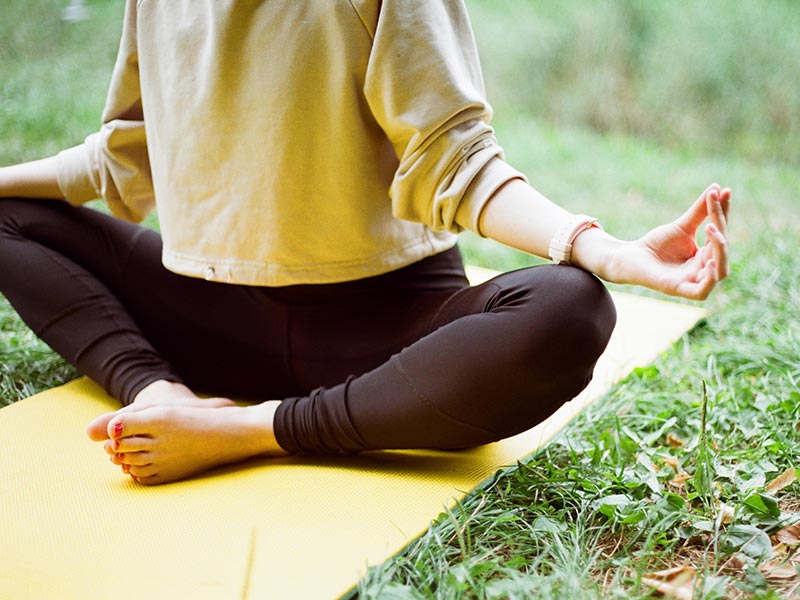
Based on the famous Chinese philosophy of Yin and Yang, Yin Yoga is the amalgamation of India’s centuries-old practice of Yoga and ancient Chinese philosophy. As per the Chinese tradition, Yang represents the active, revealing aspect of things, while Yin represents the opposite, the stable and hidden aspect, and both are complementary to each other. In Yoga, Yang exercises are vigorous, fast-paced practices such as vinyasa and ashtanga, while Yin Yoga is slow, meditative and passive.
Yin Yoga: A Brief Background

(Photo Credit: Unsplash)
While in other Yogic practices, one switches from one pose to another, resembling a flow. Juxtaposed, in Yin Yoga, a practitioner stays in one pose for a longer duration of time, from 2 to 5 minutes, or sometimes even 20 minutes, while breathing gently.
Holding stretches for a long time has been part of Chinese practices for centuries. Yin Yoga borrows a lot from the Chinese philosophy of Taoism, according to which every human being should live in a state of harmony with the universe and the energy found in it, called Qi (or, Chi). This energy runs through our body and with stretching and deep poses in Yin Yoga, any blockage is opened up, thus releasing the energy.
Also read: 5 Basic Yoga Asanas For Boosting Memory And Concentration
Yin Yoga: How it is practiced
Extremely simple conceptually, in Yin Yoga, you hold a single pose for a long time, while maintaining gentle breathwork. Seated and reclined poses, such as butterfly fold and frog pose, are part of a Yin Yoga practice. A Yoga mat and comfortable clothing are all you need!
However, there are certain things that you should keep in mind. Here are some of those:
- Stillness: Since it is based on the stable and non-moving aspect of things, or Yin, try to find stillness in your practice. Don’t fidget. Maintaining those poses for so long can be discomforting, but try to find ‘comfort in the discomfort’. However, don’t stretch to a point where it is painful. Whenever you feel the strain, you know you’ve gone too far.
- Breathe deep: Breathing gently and deeply is an equally important aspect of Yin Yoga as staying in those poses. It can seem challenging, but try to connect it with life. Take breathing in poses as staying calm in the face of challenges that life throws at us. What you can do is, try to get your inhale as long as your exhale, by counting till four, then try to get your exhale longer than your inhale.
Also read: Pre And Post Yoga Workout Routine For Optimal Health Benefits
Yin Yoga: Benefits

(Photo Credit: Unsplash)
Although appearing as still and uneventful, Yin Yoga has several benefits:
- Connective tissues: Although not much talked about in fitness circles, fascia is a connective tissue that provides structure to our body and connects one organ to the other, such as muscles to bones. When underused, fascia can become stiff, leading to aches and pain. This is where Yin Yoga comes into play. When you hold deep poses for a long duration, it stretches this tissue, making it stronger and elastic.
- Flexibility: It’s no secret that Yoga helps with flexibility. And in Yin Yoga, you hold deep poses for long, making your joints flexible and fascia elastic, helping you with overall flexibility.
- Stress: Practice Yin Yoga for just 30 minutes and you’ll feel a surreal calm. Many believe that the practice helps you with stress and anxiety. When you hold a pose for long, you are left with your thoughts with that time and Yin Yoga gives you the time and opportunity to understand them and not react, inducing a sense of calm.
- Slow down: Yoga and breathwork help you slow down. Practice Yin Yoga and all your hassles, deadlines, worries and concerns will appear to just melt away.
- Stepping stone to meditation: Instead of googling ‘how to meditate’, slip a Yin Yoga practice into your routine. In our daily life, all that activity does not allow us to understand our true selves. In Yin Yoga, since there is physical stillness and mental peace (or maybe not, but you can always get better at it), this Yoga practice is considered a stepping stone towards meditation.
From the outside, Yin Yoga might not look as beneficial as its fast-paced counterparts. But as you’ve already gone through its benefits, remember you need to balance your Yang with Yin for complete balance and harmony.
Read more articles on Yoga
Photo Credit: Unsplash
Also watch this video
How we keep this article up to date:
We work with experts and keep a close eye on the latest in health and wellness. Whenever there is a new research or helpful information, we update our articles with accurate and useful advice.
Current Version
